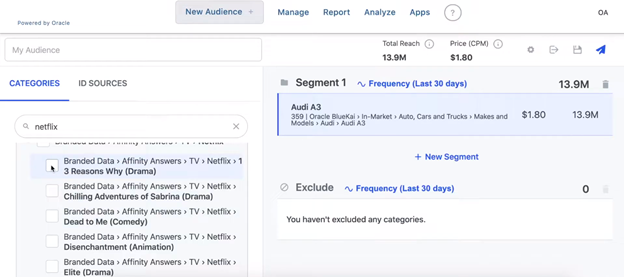
Oracle Sharding Database-powered BlueKai DMP on OCI
The Oracle BlueKai DMP (abbr. for data management platform) is the world’s most extensively adopted big data platform, for businesses that rely on actionable information and analytics on targeted audiences, for building the 21st century bespoke marketing campaigns. Coupled with the Oracle Sharding Database for seamless horizontal scalability and ACID compliance, deployed on the Oracle Cloud distributed across the 36 OCI Regions, Oracle BlueKai DMP offers the broadest spectrum of features, innovations, and value propositions.
First things first: Data structures
One has to start with the refined structuring of the massive data inside the Oracle BlueKai DMP. It is not a surprise to see marketing firms (or, departments in large corporations) to opt for the Oracle’s data management platform merely for its data arrangement, which allows for a painless navigation across ‘lakes’ of data. Plus, with Oracle ID Graph’s collection, correlation, and corroboration in real-time attributes, it gets even easier.

Caption: Depicting Oracle DMP’s data structures interface for seamless navigation
Oracle BlueKai DMP: the largest pool of audience data and analytical insights, for micro-targeting, and intent-based marketing initiatives
The next big feature of the Oracle BlueKai DMP is that – it is the powerhouse of customer data and analytics for unlocking the most granular details, for the purpose of (but, not limited to) —
- analyzing, planning, segmenting, and micro-targeting large and compact groups, across channels
- accurately exploring and establishing the customer persona
- creating bespoke content for marketing campaigns, and dynamic websites
- systematically collecting, storing, retrieving, and exchanging data
- improving focus on conversion points, via IDs
- boosting engagement success
- accessing the built-in 3rd-party data library / store for audience activation,
- deep campaign performance metrics, complex analytical operations, etc.
And, is hence packed with data management innovations like —
- unique counting/overlapping analysis at scale
- integration with custom advertising and marketing ecosystem
- powerful audience taxonomies
- data streaming, distributed batch data processing, real-time key value databases, and workflow management
- algorithms for content classification, and so forth
Oracle Sharding Database powering the Oracle BlueKai DMP, on OCI: the largest relational OLTP database deployment
Moving forward, here comes yet another crucial aspect of Oracle BlueKai DMP running on OCI, with the database sharding feature. In an Oracle’s in-house discussion between Shailesh Dwivedi, Vice President, Product Management, and Matt Abrams, the Group Vice President, Engineering, Oracle DMP, published in January 2021, BlueKai’s capability to make 1 million transactions per second was announced, along with the other ground-breaking specifications.
This particularly makes the OLTP deployment the largest one, so far. And, coupled with the sharding feature for linear Scalability, businesses can now grow and simultaneously have a refined Availability, Stability, Consistency, and Performance.
But why Oracle Database Sharding for BlueKai instead of key-value stores?
Scalability: Starting with the most essential element — scalability, Oracle’s Sharding has a linear scalable architecture that enables continuous horizontal scaling, following the growth in transactions and business data volume. This is further perfected by the Oracle Sharding database’s casting of zero impact on network latency.
Availability: Oracle Sharding enhances application availability by affording fault isolation. This translates to having zero influence of a fault in one shard on the rest of the shards. Further, the Oracle BlueKai DMP is deployed in the OCI Regions with multiple availability domains containing the primary shards.
Failovers: Oracle Data Guard always keeps a standby instance in a separate availability domain. Therefore, irrespective of the possible hardware failures owing to the high rate of transaction and writing intensity of the Oracle DMP, the failovers are swift and easy — affording a robustly secured environment, against not merely the failures occurred in availability domains, but also in the entire OCI Regions.
Stability: According to Matt Abrams, there has been not a single database outage pertaining to software faults. A promise from the Vice President of Oracle BlueKai DMP says it all about the stability of the entire platform, the sharding database, and the embedded infrastructure.
Performance: Coming to the single-most important part, the reason Oracle BlueKai DMP leverages Sharding instead of key-value stores (which also has a similar horizontal scaling capacity) is because of the unique performance gains manifested by the former, while leaving the traditional features untouched, and under regular utilization. Moreover, while reconsidering between value-key stores and Oracle Sharding, it should not be a single database but multiple databases in mind, each performing in a specific sphere.




